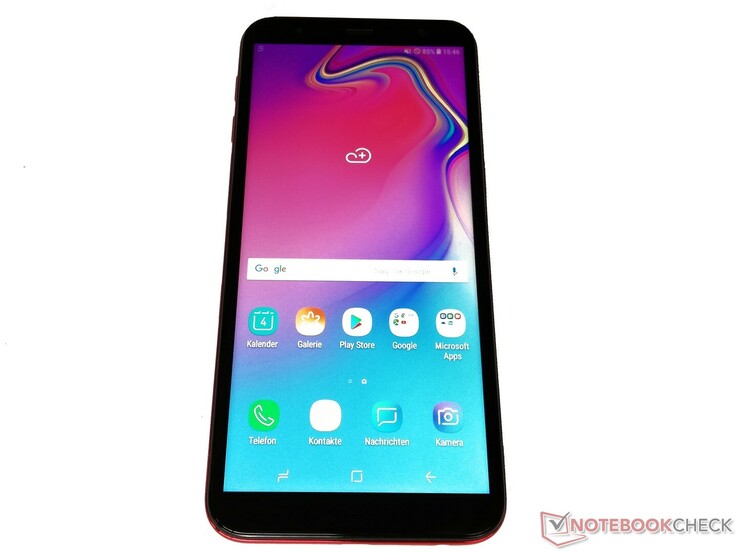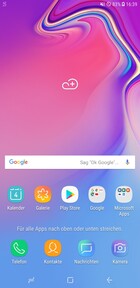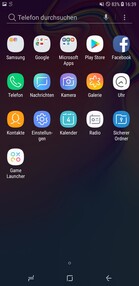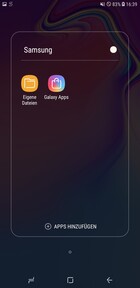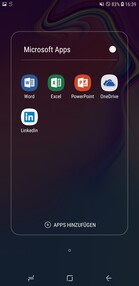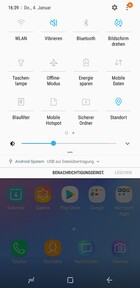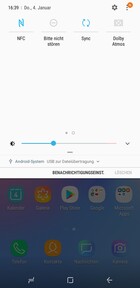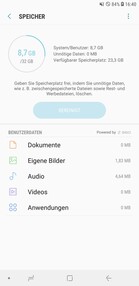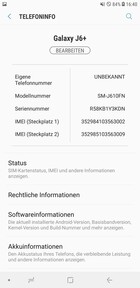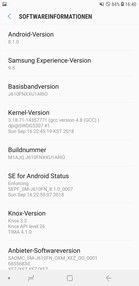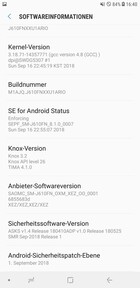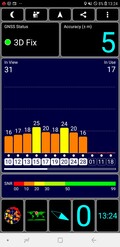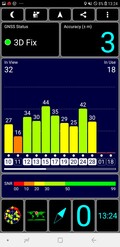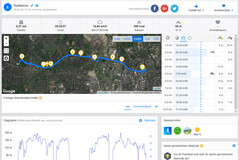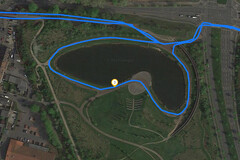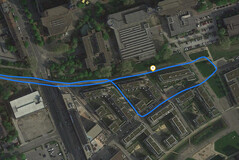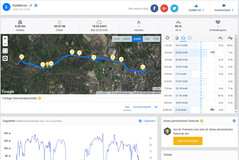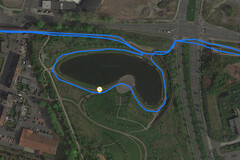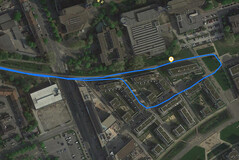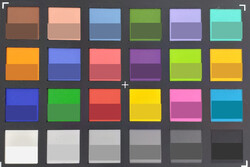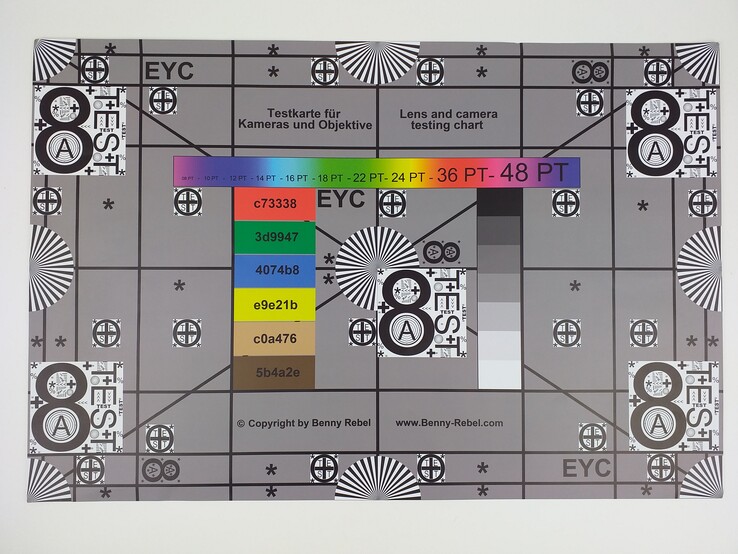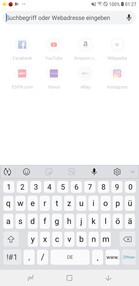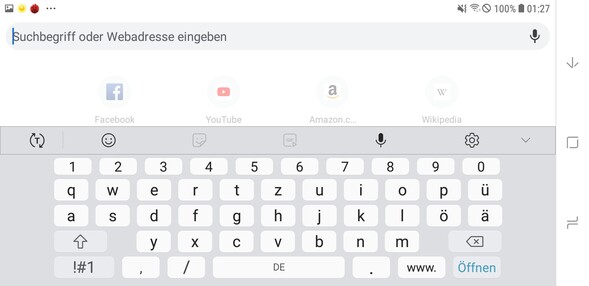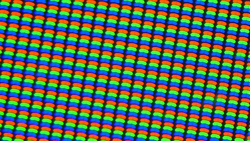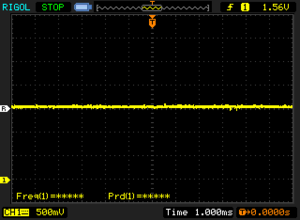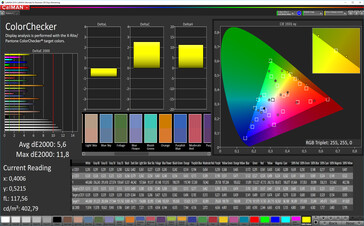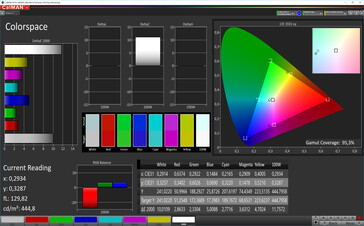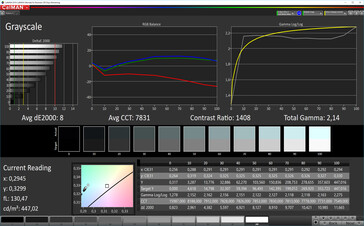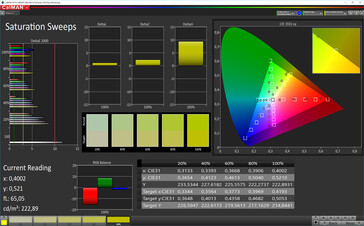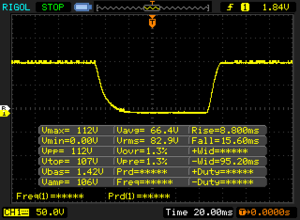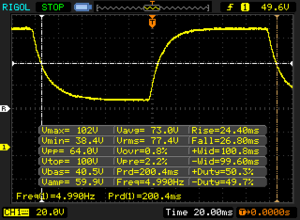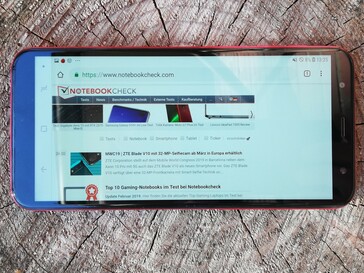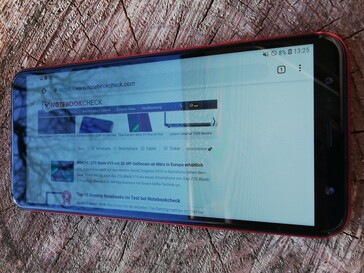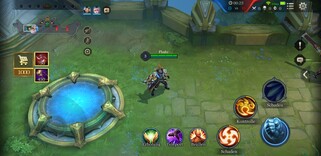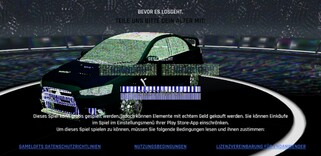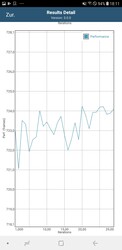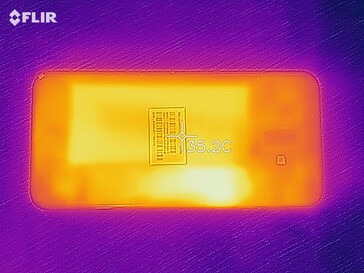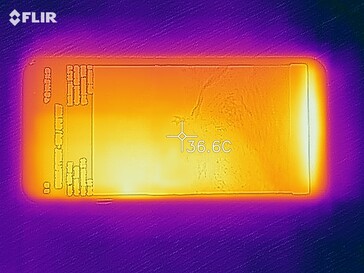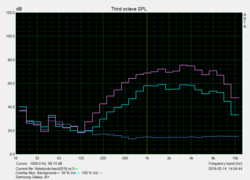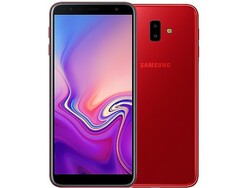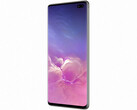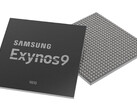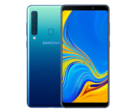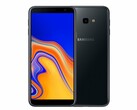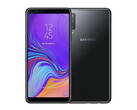Samsung Galaxy J6+ (2018) Smartphone Review
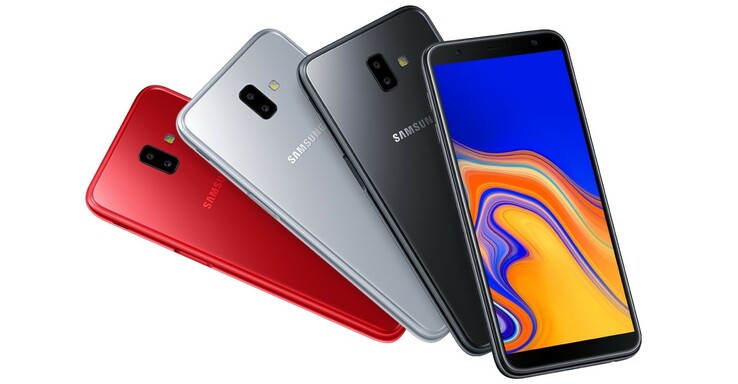
Samsung’s smartphone range extends from high-end devices all the way to entry-level smartphones for users with moderate expectations or those on a small budget. However, this does not mean that the cheaper devices suffer from poor quality, and Samsung continues to deliver a decent balance between performance, design, and rigidity even in the low-cost market of budget devices. Case in point: today’s review unit, the Samsung Galaxy J6+.
Equipped with a Qualcomm Snapdragon 425, 3GB of RAM, and a Qualcomm Adreno 308 GPU the device is reasonably fast and offers 32 GB of internal eMMC storage. At a price of just under $200 at the time of writing the J6+ hits pretty much the sweet spot in the entry-level smartphones class.
However, competition is fierce in this segment, and Samsung’s Android smartphone must prove itself against a wide variety of rivals. Among others, these are the Sharp D10, the Motorola One, and the Sony Xperia XA2 Plus as well as in-house competitors: the Galaxy A7 (2018) and Galaxy J7 (2017).
Case
The J6+ is available in three different colors, and the metal frame along the sides as well as the entire glass rear are either red, gray, or black. The rear also houses a dual-camera as well as an LED flash. The fingerprint reader has been relocated and integrated into the power button on the right-hand side. Instead of a notch at the front the J6+ features rather thick top and bottom bezels.
Feedback and accentuation point for all physical buttons were very pleasant, and there are two separate slots on the left-hand side; one for the primary Nano SIM and one for the secondary Nano SIM along with an additional microSD card.
Compared with other smartphones of its class the J6+’s footprint definitely stands out, however its weight of 178 g (~6.3 oz) remains average.
Connectivity
The J6 Plus is equipped with a Qualcomm Snapdragon 425, an Adreno 308 GPU, 3 GB of RAM and 32 GB of eMMC flash storage. The latter can be expanded with microSD cards of up to 512 GB, supported file formats include FAT, FAT32, and exFAT. Installing a microSD card does not limit the phone’s dual SIM capabilities since the J6 Plus offers two separate slots for the secondary Nano SIM and the microSD card. Unfortunately, only the first SIM supports LTE and VoLTE. As always the latter requires support by your carrier and must be included in your plan. The secondary SIM slot supports 2G (GSM) and 3G (UMTS) networks only. VoWiFi is not supported at all.
A MicroUSB port is located at the bottom and can be used for data transfers. Unfortunately, it only supports USB 2.0 speeds. On the plus side, the J6+ includes support for various OTG features, such as charging external devices. It also includes a 3.5-mm headphone jack for wired analog speakers or headsets.
Software
At the time of writing, the J6+ was running Android Oreo 8.1 with security patches as of September 1, 2018. The operating system was also running the Samsung Experience 9.5 skin, which experienced Samsung users will be instantly familiar with. Beginners and first-time Samsung users will benefit from the menu structure as well as the well-arranged app layout. Although Samsung is planning to provide a major update for its J-series smartphone series, we do not expect to see Android Pie on the Galaxy J6+ due to its limited system performance.
In addition to a handful of modified applications for telephone, file management and more, Samsung has also preloaded its phone with various third-party apps, such as FaceBook and a number of Microsoft apps. These can only be disabled in the settings but not removed completely. Offloading apps to SD is also not supported on the J6+.
Thanks to support for L1 standard DRM management, streaming content from Amazon Prime or Netflix can be enjoyed in HD.
Communication and GPS
The Galaxy J6 Plus connects to 2G, 3G, and 4G LTE cellular networks. The LTE modem is an LTE cat. 4 unit, which means transfer speeds of up to 150 Mbps down and 50 Mbps up. The phone also supports NFC, Bluetooth 4.2, Wi-Fi, and the ANT+ low-power wireless protocol. The latter connects to compatible fitness trackers, blood pressure meters, and smart watches.
Wi-Fi is limited to 802.11 b/g/n, and therefore does not support the faster 5 GHz band. Accordingly, Wi-Fi performance was poor, and with just 52.6 Mbps (RX) and 43.1 Mbps (TX) the J6+ was the slowest device in our test group by a long shot.
We test GPS accuracy with the app GPS test. The Galaxy J6+ supports GPS, GLONASS, and Beidou location services and turned out to be fairly accurate outdoors (3m/~10 ft) as well as indoors (5m/~16 ft).
We also take every device on a quick bicycle tour around the block in order to compare it to a professional Garmin Edge 520 satnav. Surprisingly enough, the J6 Plus’s GNSS was more accurate in corners and turns than on straights. Long story short: the devices is more than capable of occasional and even somewhat ambitious navigation purposes.
Telephony and Call Quality
Samsung includes its own telephone App with the Galaxy J6+. It offers a recent and missed calls list as well as a quick access to a dial pad. The other two tabs offer access to contacts and locations linked to recent callers.
Call quality was decent, and the Samsung smartphone managed to suppress ambient noise very well in order to optimize voice clarity and articulation. Voice playback was very clear and without any distortions even at high volume. Alternatively, Samsung includes a stereo headset which offers an even higher level of volume and is very well suited for making and taking phone calls.
Cameras
The Galaxy J6+ comes equipped with a 13+5 MP main camera with an f/1.9 aperture and a focal length of 29 mm as well as an f/2.2 aperture. The selfie camera at the front features a simple 8 MP sensor with an f/1.9 aperture. It worked very well in capturing portraits with rich detail and well-defined transitions. Our sample photo turned out slightly overexposed with somewhat pale colors. The camera settings menu is very short and only allows for a few quality adjustments, including a soft-focus filter, a filter for more pronounced colors, and some AR-supported adjustments such as a narrower face or bigger eyes. A professional mode with manual adjustments is not supported.
The J6+’s main camera shot panorama photos rich in detail. When zoomed in, we found visible blur around the edges of individual objects that were not visible otherwise. Significant differences in brightness resulted in unevenly illuminated planes on which shadows and dark elements in general lacked detail. In close-up range the J6+ had less trouble dealing with these differences in brightness, but it showed the same blur around the edges and transitions that we had already noticed in the panorama photos albeit they were more noticeable. Colors were pale, but well differentiated from one another. Poor lighting conditions resulted in clearly visible and distinguishable objects with slightly distorted colors and a very noticeable blur. Objects in the photos remained clearly distinguishable and visible yet got darker and darker towards the edges. In addition to the settings already listed for the front-facing camera, the main camera also supports stickers, a live focus, and a professional mode for manual brightness, white balance, and ISO adjustments.
Video quality was similar to photo quality by and large. Minor shake and wiggle is ironed out by image stabilization, and the settings allow for a manual white balance and brightness adjustment. Supported video resolutions include FHD, HD, 1920x936 (18.5:9 aspect ratio), and 1072x1072 (square). A high-framerate mode is not supported.
We test every smartphone in our lab under normalized conditions with the ColorChecker Passport, and the Galaxy J6+ suffered from major overexposure of all colors and grays across the entire spectrum. Only whites were darker than they should be.
The test chart photo was decent overall. Details and fine structures were clearly visible, however colors were noticeably overexposed and the bottom two edges showed a very distinct paleness.
Accessories and Warranty
Included in the box are a modular USB power supply with matching MicroUSB cable, a stereo headset, and a SIM tool. In addition, Samsung offers various protective cases in various colors as well as general smartphone accessories that are not model-specific, such as headsets, power banks, power supplies, and more.
Warranty is a bit tricky. While European customers get a full 24 months of warranty, customers in the US have to be careful: most devices sold through online retailers do not come with any US warranty at all.
Input Devices & Handling
Samsung’s keyboard app offers fast and simple methods for text input, even for longer texts. Various aspects of the keyboard, including size, layout, and color can be individualized according to one’s liking. The touchscreen was very responsive and smooth, and was thus well-suited for prolonged drag & drop operations. The orientation sensor reacted very quickly when the phone was rotated, and screen orientation was adjusted almost instantaneously.
Unlocking the Galaxy J6+ can be achieved via either a 2D face unlock or a fingerprint reader. Face detection only worked reliably in bright light, and the fingerprint reader had to be covered completely in order to initiate detection and unlock the phone.
Display
The 6-inch 18.5:9 TFT display runs at a native resolution of 1450x720 pixels. Its average maximum brightness of around 508 nits landed the device somewhere mid-field among its competitors. Maximum brightness without ambient light sensor support is limited to just 446 nits, and the APL50 test yielded a brightness of 515 nits. Its brightness distribution of 95 % was excellent and the best among its competitors.
| |||||||||||||||||||||||||
Brightness Distribution: 95 %
Center on Battery: 512 cd/m²
Contrast: 1829:1 (Black: 0.28 cd/m²)
ΔE ColorChecker Calman: 5.6 | ∀{0.5-29.43 Ø4.77}
ΔE Greyscale Calman: 8 | ∀{0.09-98 Ø5}
95.3% sRGB (Calman 2D)
Gamma: 2.14
CCT: 7831 K
| Samsung Galaxy J6 Plus 2018 TFT, 1480x720, 6" | Samsung Galaxy A7 2018 Super AMOLED, 2220x1080, 6" | Samsung Galaxy J7 2017 Super AMOLED, 1920x1080, 5.5" | Sharp D10 IPS, 2160x1080, 5.9" | Motorola One IPS, 1520x720, 5.9" | Sony Xperia XA2 Plus IPS, 2160x1080, 6" | |
|---|---|---|---|---|---|---|
| Screen | 41% | 28% | 1% | -2% | 24% | |
| Brightness middle (cd/m²) | 512 | 570 11% | 454 -11% | 745 46% | 467 -9% | 597 17% |
| Brightness (cd/m²) | 508 | 565 11% | 463 -9% | 723 42% | 452 -11% | 592 17% |
| Brightness Distribution (%) | 95 | 93 -2% | 86 -9% | 89 -6% | 87 -8% | 92 -3% |
| Black Level * (cd/m²) | 0.28 | 0.6 -114% | 0.38 -36% | 0.32 -14% | ||
| Contrast (:1) | 1829 | 1242 -32% | 1229 -33% | 1866 2% | ||
| Colorchecker dE 2000 * | 5.6 | 1.5 73% | 2 64% | 4.52 19% | 5.29 6% | 2.4 57% |
| Colorchecker dE 2000 max. * | 11.8 | 3.6 69% | 5.3 55% | 9.14 23% | 7.71 35% | 5.3 55% |
| Greyscale dE 2000 * | 8 | 1.2 85% | 1.7 79% | 5.8 27% | 5 37% | 3.4 57% |
| Gamma | 2.14 103% | 2.07 106% | 2.1 105% | 2.262 97% | 2.376 93% | 2.2 100% |
| CCT | 7831 83% | 6504 100% | 6394 102% | 7660 85% | 7583 86% | 7172 91% |
* ... smaller is better
Screen Flickering / PWM (Pulse-Width Modulation)
| Screen flickering / PWM not detected | |||
In comparison: 53 % of all tested devices do not use PWM to dim the display. If PWM was detected, an average of 8083 (minimum: 5 - maximum: 343500) Hz was measured. | |||
The contrast ratio of 1,829:1 and a black level of 0.28 nits were excellent as well. Blacks were comparatively dark, and colors were very clearly delimited from one another.
Our CalMAN analysis showed fairly balanced blues and greens on the one hand, and lacking reds on the other. Color balance cannot be manually adjusted, and the only color-related setting we found was a blue-filter mode resulting in a considerable red tint.
Display Response Times
| ↔ Response Time Black to White | ||
|---|---|---|
| 24.4 ms ... rise ↗ and fall ↘ combined | ↗ 8.8 ms rise | |
| ↘ 15.6 ms fall | ||
| The screen shows good response rates in our tests, but may be too slow for competitive gamers. In comparison, all tested devices range from 0.1 (minimum) to 240 (maximum) ms. » 56 % of all devices are better. This means that the measured response time is worse than the average of all tested devices (20.2 ms). | ||
| ↔ Response Time 50% Grey to 80% Grey | ||
| 51.2 ms ... rise ↗ and fall ↘ combined | ↗ 24.4 ms rise | |
| ↘ 26.8 ms fall | ||
| The screen shows slow response rates in our tests and will be unsatisfactory for gamers. In comparison, all tested devices range from 0.165 (minimum) to 636 (maximum) ms. » 88 % of all devices are better. This means that the measured response time is worse than the average of all tested devices (31.6 ms). | ||
Performance
Thanks to a Qualcomm Snapdragon 425, an Adreno 308 GPU and 3 GB of RAM, overall performance was mostly smooth. A total of 32 GB of internal eMMC flash storage should offer plenty of space for everyday apps. Most of the J6+’s competitors at a comparable price point are better equipped.
Consequently, more often than not the Galaxy J6+ can be found in the last place in our benchmarks. The results were strikingly similar to the older Samsung Galaxy J7 2017. Subjectively speaking the device was powerful enough to run everyday apps smoothly and with only minor frame drops.
The browser benchmark results painted a similar picture, and the J6+ was outperformed by every single one of its competitors save for the WebXPRT 2015 test in which it scored barely high enough to land in second to last place instead.
Everyday usage seemed fast and scrolling was smooth. However, media content heavy websites can occasionally stall for significant amounts of time or even fail to load.
| JetStream 1.1 - Total Score | |
| Samsung Galaxy A7 2018 (Chrome 70) | |
| Sharp D10 (Chrome 70) | |
| Sony Xperia XA2 Plus (Chrome 67) | |
| Samsung Galaxy J7 2017 (Samsung Browser 5.4) | |
| Motorola One (Chrome 69) | |
| Samsung Galaxy J6 Plus 2018 (Chrome 72) | |
| Average Qualcomm Snapdragon 425 (MSM8917) (15.5 - 18.7, n=16) | |
| Octane V2 - Total Score | |
| Average of class Smartphone (2228 - 126661, n=195, last 2 years) | |
| Samsung Galaxy A7 2018 (Chrome 70) | |
| Sony Xperia XA2 Plus (Chrome 67) | |
| Sharp D10 (Chrome 70) | |
| Samsung Galaxy J7 2017 (Samsung Browser 5.4) | |
| Motorola One (Chrome 69) | |
| Samsung Galaxy J6 Plus 2018 (Chrome 72) | |
| Average Qualcomm Snapdragon 425 (MSM8917) (2411 - 3374, n=17) | |
| Mozilla Kraken 1.1 - Total | |
| Samsung Galaxy J6 Plus 2018 (Chrome 72) | |
| Average Qualcomm Snapdragon 425 (MSM8917) (10742 - 16192, n=17) | |
| Motorola One (Chrome 69) | |
| Sony Xperia XA2 Plus (Chrome 67) | |
| Sharp D10 (Chrome 70) | |
| Samsung Galaxy J7 2017 (Samsung Browser 5.4) | |
| Samsung Galaxy A7 2018 (Chrome 70) | |
| Average of class Smartphone (257 - 28190, n=155, last 2 years) | |
| WebXPRT 3 - Overall | |
| Average of class Smartphone (38 - 380, n=30, last 2 years) | |
| Samsung Galaxy A7 2018 (Chrome 70) | |
| Sony Xperia XA2 Plus (Chrome 67) | |
| Average Qualcomm Snapdragon 425 (MSM8917) (24 - 28, n=5) | |
| Samsung Galaxy J6 Plus 2018 (Chrome 72) | |
| WebXPRT 2015 - Overall | |
| Samsung Galaxy A7 2018 (Chrome 70) | |
| Motorola One (Chrome 69) | |
| Sony Xperia XA2 Plus (Chrome 67) | |
| Samsung Galaxy J6 Plus 2018 (Chrome 72) | |
| Samsung Galaxy J7 2017 (Samsung Browser 5.4) | |
| Average Qualcomm Snapdragon 425 (MSM8917) (62 - 79, n=8) | |
* ... smaller is better
A total of 32 GB of eMMC flash storage is installed, and around 23 GB thereof was available for apps and data. While its write and read performance was below average in our benchmarks, we failed to notice anything in day-to-day use.
The internal microSD card reader supports microSD cards of up to 512 GB. When benchmarked with our Toshiba Exceria Pro M501 reference card it performed on a level comparable to the J6+'s competitors.
| Samsung Galaxy J6 Plus 2018 | Samsung Galaxy A7 2018 | Samsung Galaxy J7 2017 | Sharp D10 | Motorola One | Sony Xperia XA2 Plus | Average 32 GB eMMC Flash | Average of class Smartphone | |
|---|---|---|---|---|---|---|---|---|
| AndroBench 3-5 | 12% | -25% | 22% | 94% | 12% | 2% | 1376% | |
| Sequential Read 256KB (MB/s) | 292.9 | 295.8 1% | 198.5 -32% | 280.7 -4% | 280.2 -4% | 281.1 -4% | 242 ? -17% | 2240 ? 665% |
| Sequential Write 256KB (MB/s) | 95.6 | 104.9 10% | 53 -45% | 211.5 121% | 214.9 125% | 146.2 53% | 100.5 ? 5% | 1877 ? 1863% |
| Random Read 4KB (MB/s) | 64.6 | 84 30% | 25.86 -60% | 47.2 -27% | 61.9 -4% | 77.4 20% | 43.1 ? -33% | 298 ? 361% |
| Random Write 4KB (MB/s) | 12.71 | 15.45 22% | 10.54 -17% | 16.79 32% | 69.1 444% | 10.5 -17% | 22.3 ? 75% | 345 ? 2614% |
| Sequential Read 256KB SDCard (MB/s) | 76.6 ? | 78.2 ? 2% | 76.1 ? -1% | 83.2 ? 9% | 80.8 ? 5% | 86 ? 12% | 71.8 ? -6% | |
| Sequential Write 256KB SDCard (MB/s) | 61.5 ? | 64.4 ? 5% | 63.9 ? 4% | 63.6 ? 3% | 60.9 ? -1% | 67 ? 9% | 52.9 ? -14% |
Gaming
All things graphics are handled by a Qualcomm Adreno 308, which is very limited when it comes to modern demanding games and failed to render many of the games we tested properly. For example, "Asphalt 9: Legends" suffered from massive image artifacts rendering the game all but unplayable. In "Arena of Valor" we noticed occasional massive frame drops even on low settings, particularly in scenes with a large number of light effects. Casual games should remain playable on the J6+ albeit loading times can be longer than expected.
Touchscreen controls in games worked flawlessly. It responded quickly and reliably, and its smooth surface allowed for extended and drag and drop operations without wearing out the finger tips. The orientation sensor was very quick to react.
Arena of Valor
Temple Run 2
Emissions
Temperature
In our tests, we were able to measure surface temperatures of 31 °C (~88 °F) when idle and slightly over 33 °C (~91 °F) under load. Accordingly, the Samsung Galaxy J6+ remained fairly cool overall and never got too warm to become uncomfortable to be held in hand. GFXBench ES2.0’s sustained load test showed that performance did not decrease over time, and the J6+ was capable of maintaining its high initial level of performance over long periods of time.
(+) The maximum temperature on the upper side is 31.9 °C / 89 F, compared to the average of 35.2 °C / 95 F, ranging from 21.9 to 247 °C for the class Smartphone.
(+) The bottom heats up to a maximum of 33.4 °C / 92 F, compared to the average of 34 °C / 93 F
(+) In idle usage, the average temperature for the upper side is 28.8 °C / 84 F, compared to the device average of 32.9 °C / 91 F.
Speakers
The single speaker was comparatively loud and balanced with a focus on mids for a clear reproduction of voices and music. However, we strongly suggest headphones or external speakers for an improved audio experience. These can be connected either wirelessly via Bluetooth 4.2 or with a 3.5-mm audio cable via the integrated headphone jack. The port was firm and did not have a detrimental effect on sound quality.
The included headset was good enough for audio contents and overall louder than the integrated speaker. However, third-party accessories should offer a much higher level of quality.
Samsung Galaxy J6 Plus 2018 audio analysis
(+) | speakers can play relatively loud (83 dB)
Bass 100 - 315 Hz
(-) | nearly no bass - on average 34.4% lower than median
(±) | linearity of bass is average (12% delta to prev. frequency)
Mids 400 - 2000 Hz
(+) | balanced mids - only 4.3% away from median
(+) | mids are linear (6.1% delta to prev. frequency)
Highs 2 - 16 kHz
(+) | balanced highs - only 4% away from median
(+) | highs are linear (5.7% delta to prev. frequency)
Overall 100 - 16.000 Hz
(±) | linearity of overall sound is average (24.9% difference to median)
Compared to same class
» 61% of all tested devices in this class were better, 7% similar, 33% worse
» The best had a delta of 11%, average was 35%, worst was 134%
Compared to all devices tested
» 75% of all tested devices were better, 5% similar, 19% worse
» The best had a delta of 4%, average was 24%, worst was 134%
Sharp D10 audio analysis
(±) | speaker loudness is average but good (80.3 dB)
Bass 100 - 315 Hz
(-) | nearly no bass - on average 61.6% lower than median
(+) | bass is linear (0% delta to prev. frequency)
Mids 400 - 2000 Hz
(-) | nearly no mids - on average 61.6% lower than median
(+) | mids are linear (0% delta to prev. frequency)
Highs 2 - 16 kHz
(-) | nearly no highs - on average 61.6% lower than median
(+) | highs are linear (0% delta to prev. frequency)
Overall 100 - 16.000 Hz
(-) | overall sound is not linear (117.6% difference to median)
Compared to same class
» 87% of all tested devices in this class were better, 7% similar, 5% worse
» The best had a delta of 11%, average was 35%, worst was 134%
Compared to all devices tested
» 96% of all tested devices were better, 2% similar, 2% worse
» The best had a delta of 4%, average was 24%, worst was 134%
Power Management
Power Consumption
According to our measurements, the Galaxy J6+ consumed between 0.64 W when idle and 6.38 W under load. Accordingly, while it remained a fairly energy efficient device overall, it was outperformed by many of its competitors.
The included 5-W charger is not powerful enough to provide the Samsung Galaxy J6+ with enough energy under load to simultaneously charge the battery.
| Off / Standby | |
| Idle | |
| Load |
|
Key:
min: | |
| Samsung Galaxy J6 Plus 2018 3300 mAh | Samsung Galaxy A7 2018 3300 mAh | Samsung Galaxy J7 2017 3600 mAh | Sharp D10 2900 mAh | Motorola One 3000 mAh | Sony Xperia XA2 Plus 3580 mAh | Average Qualcomm Snapdragon 425 (MSM8917) | Average of class Smartphone | |
|---|---|---|---|---|---|---|---|---|
| Power Consumption | 2% | 47% | 21% | 1% | 21% | -21% | -23% | |
| Idle Minimum * (Watt) | 0.64 | 0.71 -11% | 0.39 39% | 0.7 -9% | 1 -56% | 0.35 45% | 1.113 ? -74% | 0.847 ? -32% |
| Idle Average * (Watt) | 1.81 | 1.36 25% | 1.06 41% | 1 45% | 1.6 12% | 1.81 -0% | 2.19 ? -21% | 1.446 ? 20% |
| Idle Maximum * (Watt) | 1.91 | 1.47 23% | 1.08 43% | 1.4 27% | 2 -5% | 1.83 4% | 2.55 ? -34% | 1.63 ? 15% |
| Load Average * (Watt) | 4.88 | 5.13 -5% | 1.82 63% | 3.7 24% | 3.3 32% | 3.31 32% | 4.32 ? 11% | 6.95 ? -42% |
| Load Maximum * (Watt) | 6.38 | 7.89 -24% | 3.21 50% | 5.2 18% | 5.1 20% | 4.97 22% | 5.5 ? 14% | 11.3 ? -77% |
* ... smaller is better
Battery Life
In our real-world Wi-Fi test, the J6 Plus lasted for almost 11 hours before it had to be recharged. Overall, the results were average and the device was outperformed by the likes of the Motorola One with a significantly smaller battery.
The included charger does not support fast charging, and accordingly it took just over three hours to fully charge the battery from near empty.
| Samsung Galaxy J6 Plus 2018 3300 mAh | Samsung Galaxy A7 2018 3300 mAh | Samsung Galaxy J7 2017 3600 mAh | Sharp D10 2900 mAh | Motorola One 3000 mAh | Sony Xperia XA2 Plus 3580 mAh | |
|---|---|---|---|---|---|---|
| Battery runtime | -4% | 46% | -2% | 0% | 69% | |
| Reader / Idle (h) | 34.7 | 24.5 -29% | 32.5 -6% | 27.5 -21% | 78 125% | |
| H.264 (h) | 11.8 | 13.9 18% | 18.3 55% | 12.8 8% | 14.9 26% | |
| WiFi v1.3 (h) | 10.9 | 10.1 -7% | 15.1 39% | 10.7 -2% | 12.3 13% | 14 28% |
| Load (h) | 4.5 | 4.6 2% | 8.8 96% | 4.5 0% | 8.8 96% |
Pros
Cons
Verdict
Our test proved that the Samsung Galaxy J6+ is a solid and well-made smartphone with a decent touchscreen, premium materials, and a modern and appealing design. Its low price, a battery life of almost 11 hours, and decent cameras only further reinforced this first impression.
However, not all that glitters is gold and the J6+ does suffer from a few setbacks that are more obvious than on competing devices. Overall system performance is fast enough for simple tasks, however even slightly more complex websites can already be too much to ask for. Graphically demanding applications either do not run at all or require a lot of patience while loading. Internal memory is limited to just 32 GB, which is particularly scarce considering that apps cannot be offloaded to SD on this device at all. Competitors at the J6+’s MSRP of $250 should run circles around it, however at its current street price of around $180 it is definitely worth not just a closer look, but also our endorsement.
The Samsung Galaxy J6 Plus offers a premium build quality and a solid hardware configuration. Its MSRP is definitely too high, but at its current street price the device is well worth its price.
Samsung Galaxy J6 Plus 2018
- 02/28/2019 v6 (old)
Mike Wobker


